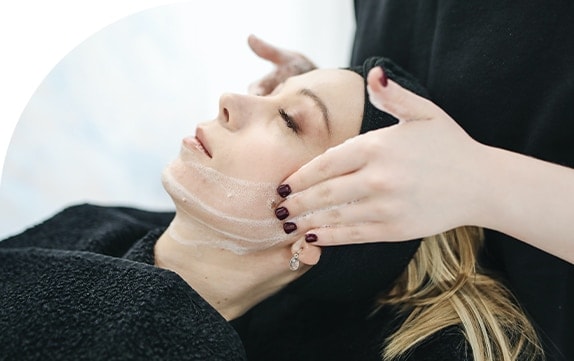The Best at Home Skin Care Routine

The Best at Home Skin Care Routine
If you have ever browsed the skincare aisle at your local store, you probably have been a bit overwhelmed. There are seems, lotions, and potions for just about everything. Not to mention those things all promise amazing results. But what exactly do you need? What should you spend your hard-earned money on, and what should you leave to gather dust on the shelves?
It’s important that when you are looking for skin care products, you first understand what type of skin conditions and type you have. There are so many combinations, from dry to oil and everything in between. In fact, you can even have two different types of conditions on the same face. What? Yes, it’s true. In fact, most of us have combination skin, as they call it. Where the skin is oily in some places and dry in others. Just to ensure you are completely confused about what to do.
But there is hope. Most skincare products offer a list of ingredients on the back of the packaging. These ingredients will help you narrow down what you are looking for. Sure, you can read the front of the package but then flip it over to find out the truth. Let’s take a look at some now.
For Oily Skin, Look for…
If you have oily skin, you should look for ingredients in your cleaners and lotions such as:
- Retinol
- Niacinamide
- Salicylic acid
- Hyaluronic acid
- Clay
- Lemongrass
- Spearmint
Meanwhile, you should avoid Occlusive moisturizers, which are moisturizers that trap moisture in the skin. Also, avoid any alcohol-based products. While alcohol removes oil temporarily, it can cause issues later on due to the harsh stripping of the oil. Harsh exfoliants are another thing that people with oily skin should avoid, as it strips the oil from the surface of the skin. This can lead to overproduction of oil.
Always follow up your cleansing routine with a nice moisturizer designed for those with oily skin to ensure you don’t clog your pores.
Of course, you should also look at having a professional facial done every 4-6 weeks. This ensures that you have your skin under control and prevents further breakouts.
For Dry Skin, Look For…
Dry skin needs different types of products, as you might expect. You should stay away from Salicylic acid, alcohol, and benzoyl peroxide. However, you should use Hyaluronic acid or Polyglutamic acid, Glycerin, Ceramides, and Shea Butter. These will all help moisturize the skin to give it a healthy glow. Of course, you should wash your face regularly with moisturizing fash wash and hydrate by drinking plenty of water. Those with dry skin should have more frequent estitician visits every 2-3 weeks.
Once you have proper products with proper ingredients, you should get into a routine of using them. Once in the morning and once in the evening is the common routine. However, there are some products that you shouldn’t use that often. Be sure that you read and follow the directions on the packaging so that you don’t cause more issues.
Detemrining Your Skin Type
Alright, so it’s all great that you now know some of the ingredients you should be looking for, but what if you don’t know your skin type? You can do a few things to determine your skin type. Remember, your skin could be a combination of oily and dry. In that case, you should treat the areas as such, meaning use products for oily skin on the areas that are oily and for dry skin on the areas that are dry. Let’s take a look at ways to decide.
Normal skin will have a good balance of oil. This means that you won’t have a dry, tight feeling and don’t seem to have the excessive oil that oily skin has. Not all oily skin has acne issues. This will depend on various factors such as hormones, diet, proper skincare, and more. So, that shouldn’t be a determining factor. In fact, people with dry skin can also have acne issues. Dry will always feel tight and in need of lotion, and oily will always tend to have a shine to it.
Combination skin is very common, mostly oily in the “T zone,” which is the area across the forehead and down the nose, while the rest of your skin could be normal to dry.
Sensitive skin gets irritated easily or often by products, the sun, wind, etc. Basically, for a variety of reasons. If you have sensitive skin, it may be some trial and error to determine which products will work best for your situation. It is recommended that you only start with one product. This will allow you to narrow down the issues more quickly. This goes for when you have a professional facial done as well.
Getting Professional Facial
Once you have set up your daily routine, found the right products, and have things underway, you’ll then want to start getting professional facials done for those problem areas, you know, the ones, we all have them.
You’ll want to decide what type of problems you have and how you’d like to address them, as there are many different types of solutions out there. Here’s some examples:
Hyperpigmentation/Brightening-Brightening facials can assist with areas of concern with pigmentation issues. If you are ready to get rid of that redness and smooth out those freckles and dark spots,s then you need to look at getting a brightening facial. There are different types available for the different skin types. Be sure that your esthetician chooses something that matches your skin’s conditions.
Clearing up Acne-Acne is a constant battle for some people. However, there are ways to clear it up. Facials are one of the better ways to go about doing this. They can deep clean, cleanse and provide the needed moisture with antibacterial properties to ensure your skin looks amazing.
Anti-aging-As we age, our skin will start to wrinkle, and crepe lines will start to appear. These lines and wrinkles are something that is a main focus for many professional estheticians. Various treatments can be utilized to accomplish anti-aging and, in many cases, assist with acne and brightening at the same time.


